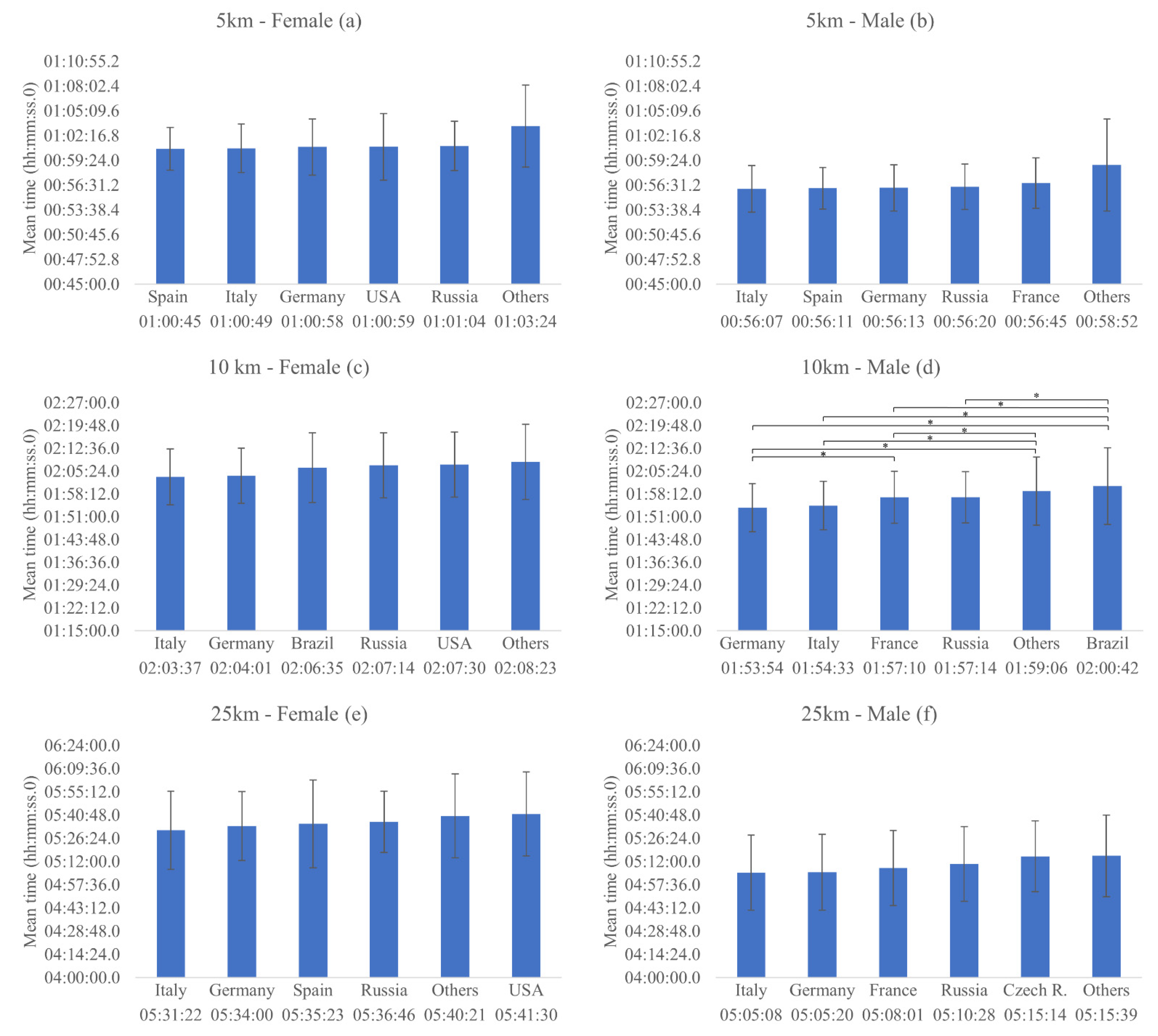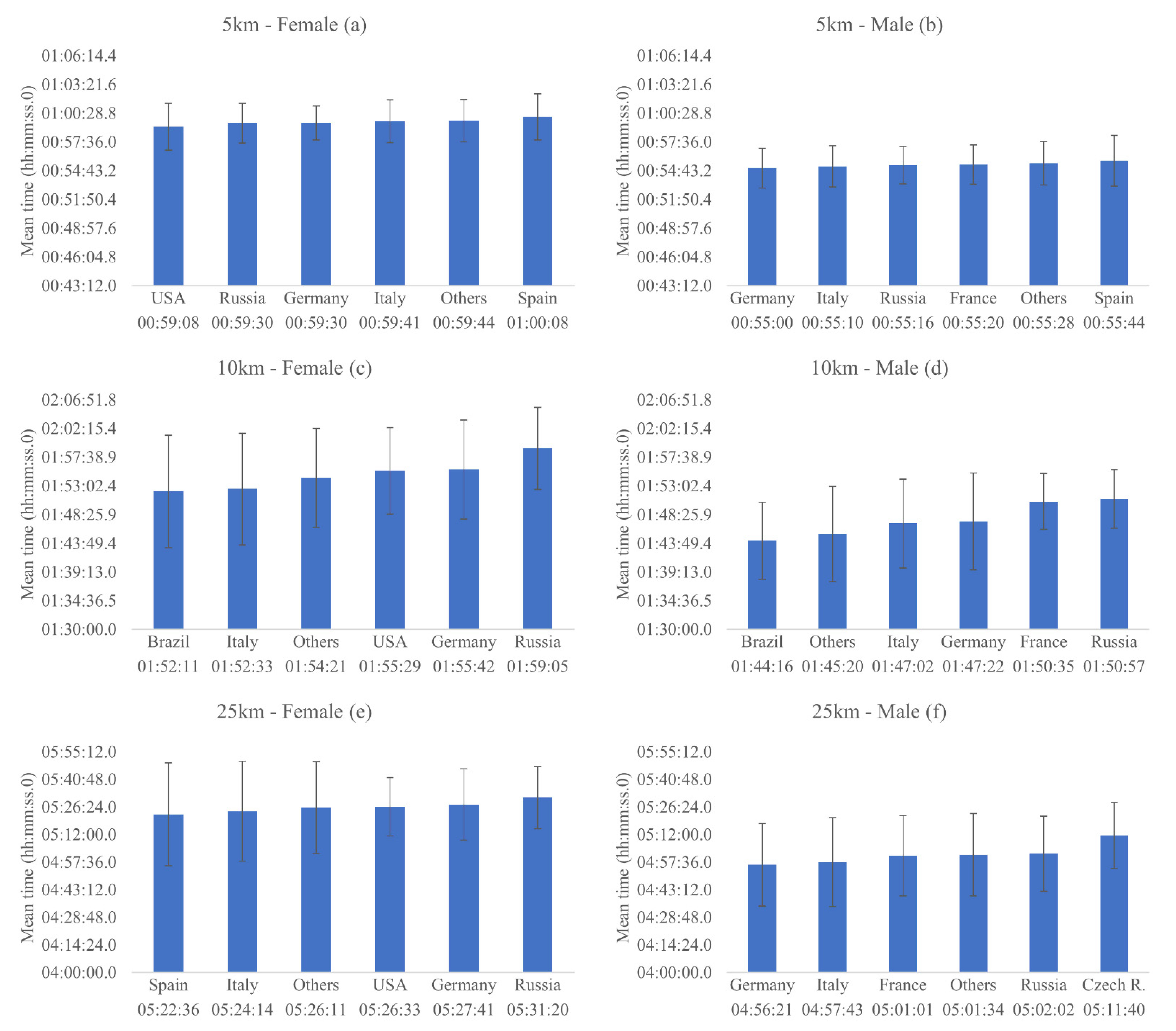Origin of the Fastest 5 km, 10 km and 25 km Open-Water Swimmers—An Analysis from 20 Years and 9819 Swimmers
Abstract
1. Introduction
2. Methods
2.1. Ethical Approval
2.2. Data
2.3. Statistical Analysis
3. Results
3.1. Comparison among All Athletes from Each Country
3.2. Comparison between Top 10 Athletes from Each Country
4. Discussion
5. Conclusions
Author Contributions
Funding
Institutional Review Board Statement
Informed Consent Statement
Data Availability Statement
Conflicts of Interest
References
- FINA. 6th FINA World Championships 1991. 2021. Available online: https://www.fina.org/competitions/1064/6th-fina-world-championships-1991 (accessed on 5 May 2021).
- Swim England. An Introduction to Open Water Swimming. 2021. Available online: https://www.swimming.org/sport/open-water-swimming/ (accessed on 15 April 2021).
- FINA. FINA Open Water Swimming Guide. 2018. Available online: https://resources.fina.org/fina/document/2021/02/03/58cd56ca-f5c2-4305-b5e7-aeb5a2c7caf3/ows_guide_new_lr2018.pdf (accessed on 5 April 2021).
- FINA. Competition Results. 2021. Available online: www.fina.org/latest-results (accessed on 5 April 2021).
- Knechtle, B.; Rosemann, T.; Rüst, C.A. Women cross the ‘Catalina Channel’ faster than men. SpringerPlus 2015, 4, 332. [Google Scholar] [CrossRef]
- Knechtle, B.; Rosemann, T.; Lepers, R.; Rüst, C.A. Women Outperform Men in Ultradistance Swimming: The Manhattan Island Marathon Swim from 1983 to 2013. Int. J. Sports Physiol. Perform. 2014, 9, 913–924. [Google Scholar] [CrossRef]
- Rüst, C.A.; Lepers, R.; Rosemann, T.; Knechtle, B. Will women soon outperform men in open-water ultra-distance swimming in the ‘Maratona del Golfo Capri-Napoli’? SpringerPlus 2014, 3, 86. [Google Scholar] [CrossRef] [PubMed]
- Nikolaidis, P.; Di Gangi, S.; De Sousa, C.V.; Valeri, F.; Rosemann, T.; Knechtle, B. Sex difference in open-water swimming—The Triple Crown of Open Water Swimming 1875–2017. PLoS ONE 2018, 13, e0202003. [Google Scholar] [CrossRef]
- Nikolaidis, P.T.; De Sousa, C.V.; Knechtle, B. Sex difference in long-distance open-water swimming races—Does nationality play a role? Res. Sports Med. 2018, 26, 332–344. [Google Scholar] [CrossRef] [PubMed]
- Zingg, M.A.; Rüst, C.A.; Rosemann, T.; Lepers, R.; Knechtle, B. Analysis of sex differences in open-water ultra-distance swimming performances in the FINA World Cup races in 5 km, 10 km and 25 km from 2000 to 2012. BMC Sports Sci. Med. Rehabil. 2014, 6, 7. [Google Scholar] [CrossRef] [PubMed]
- Tipton, M.; Bradford, C. Moving in extreme environments: Open water swimming in cold and warm water. Extrem. Physiol. Med. 2014, 3, 12. [Google Scholar] [CrossRef]
- Knechtle, B.; Nikolaidis, P.T.; Rosemann, T.; Rüst, C.A. Performance trends in 3000 m open-water age group swimmers from 25 to 89 years competing in the FINA World Championships from 1992 to 2014. Res. Sports Med. 2016, 25, 67–77. [Google Scholar] [CrossRef]
- Allen, S.V.; Vandenbogaerde, T.J.; Hopkins, W.G. Career performance trajectories of Olympic swimmers: Benchmarks for talent development. Eur. J. Sport Sci. 2014, 14, 643–651. [Google Scholar] [CrossRef]
- Allen, S.V.; Vandenbogaerde, T.J.; Hopkins, W.G. The performance effect of centralizing a nation’s elite swim program. Int. J. Sports Physiol. Perform. 2015, 10, 198–203. [Google Scholar] [CrossRef]
- Allen, S.V.; Vandenbogaerde, T.J.; Pyne, D.B.; Hopkins, W.G. Predicting a Nation’s Olympic-Qualifying Swimmers. Int. J. Sports Physiol. Perform. 2015, 10, 431–435. [Google Scholar] [CrossRef]
- Pyne, D.B.; Trewin, C.B.; Hopkins, W.G. Progression and variability of competitive performance of Olympic swimmers. J. Sports Sci. 2004, 22, 613–620. [Google Scholar] [CrossRef] [PubMed]
- Rüst, C.A.; Knechtle, B.; Rosemann, T. The Relationship between Nationality and Performance in Successful Attempts to Swim across the ‘English Channel’—A Retrospective Data Analysis from 1875 to 2012. Med. Sport. 2013, 17, 125–133. [Google Scholar] [CrossRef]
- Knechtle, B.; Rosemann, T.; Rüst, C.A. Participation and performance trends by nationality in the ‘English Channel Swim’ from 1875 to 2013. BMC Sports Sci. Med. Rehabil. 2014, 6, 34. [Google Scholar] [CrossRef][Green Version]
- Nikolaidis, P.T.; Sousa, C.V.; Knechtle, B.; Nikolaidis, P.T.; Sousa, C.V.; Knechtle, B. The relationship of wearing a wetsuit in long-distance open-water swimming with sex, age, calendar year, performance, and nationality—Crossing the “Strait of Gibraltar”. Open Access J. Sports Med. 2018, 9, 27–36. [Google Scholar] [CrossRef]
- Knechtle, B.; Dalamitros, A.A.; Barbosa, T.M.; Sousa, C.V.; Rosemann, T.; Nikolaidis, P.T. Sex Differences in Swimming Disciplines—Can Women Outperform Men in Swimming? Int. J. Environ. Res. Public Health 2020, 17, 3651. [Google Scholar] [CrossRef]
- Hill, L. Participation and Performance during the Extreme Open-Water ‘Freedom Swim’ Race from 2001 to 2018. Eur. J. Phys. Educ. Sport Sci. 2018, 4, 58–72. [Google Scholar]
- Seffrin, A.; Lira, C.A.B.; Vancini, R.L.; Santos, D.A.T.; Moser, C.; Villiger, E.; Rosemann, T.; Knechtle, B.; Hill, L.; Andrade, M.S. Italians Are the Fastest 3000 m Open-Water Master Swimmers in the World. Int. J. Environ. Res. Public Health 2021, 18, 7606. [Google Scholar] [CrossRef] [PubMed]
- Italian Open Water Tour. Available online: https://italianopenwatertour.com (accessed on 24 July 2021).
- Open Water Schwimmen. Available online: www.openwaterschwimmen.com/news/categories/open-water-schwimmen (accessed on 24 July 2021).
- Baldassarre, R.; Bonifazi, M.; Piacentini, M.F. Pacing profile in the main international open-water swimming competitions. Eur. J. Sport Sci. 2019, 19, 422–431. [Google Scholar] [CrossRef] [PubMed]
- Eichenberger, E.; Knechtle, B.; Knechtle, P.; Rüst, C.A.; Rosemann, T.; Lepers, R. Best performances by men and women open-water swimmers during the ‘English Channel Swim’ from 1900 to 2010. J. Sports Sci. 2012, 30, 1295–1301. [Google Scholar] [CrossRef] [PubMed]
- FINA. Open Water Swimming Manual 2020 Edition. 2020. Available online: https://resources.fina.org/fina/document/2021/02/03/84a6f630-7803-4915-8b27-a95e986cefc1/fina_ow_manual_2020_14may2020.pdf (accessed on 7 April 2021).
- Bradford, C.D.; Gerrard, D.F.; Cotter, J.D. Open-Water Swimming. In Heat Stress in Sport and Exercise; Springer International Publishing: Cham, Switzerland, 2019; pp. 263–281. [Google Scholar]
- Moles, K. The Social World of Outdoor Swimming: Cultural Practices, Shared Meanings, and Bodily Encounters. J. Sport Soc. Issues 2021, 45, 20–38. [Google Scholar] [CrossRef]
- Throsby, K. Immersion: Marathon Swimming, Embodiment and Identity; Manchester University Press: Manchester, UK, 2016. [Google Scholar]
- Suter, D.; Sousa, C.V.; Hill, L.; Scheer, V.; Nikolaidis, P.T.; Knechtle, B. Even pacing is associated with faster finishing times in ultramarathon distance trail running—The “ultra-trail du Mont Blanc” 2008–2019. Int. J. Environ. Res. Public Health 2020, 17, 7074. [Google Scholar] [CrossRef]
- Knechtle, B.; Scheer, V.; Nikolaidis, P.T.; Sousa, C.V. Participation and performance trends in the oldest 100-km ultramarathon in the world. Int. J. Environ. Res. Public Health 2020, 17, 1719. [Google Scholar] [CrossRef] [PubMed]
- Rüst, C.A.; Knechtle, B.; Rosemann, T.; Lepers, R. Men Cross America Faster Than Women—The “Race Across America” From 1982 to 2012. Int. J. Sports Physiol. Perform. 2013, 8, 611–617. [Google Scholar] [CrossRef] [PubMed]
- Baumgartner, S.; Sousa, C.V.; Nikolaidis, P.T.; Knechtle, B. Can the Performance Gap between Women and Men be Reduced in Ultra-Cycling? Int. J. Environ. Res. Public Health 2020, 17, 2521. [Google Scholar] [CrossRef]
- Knechtle, B.; Stjepanovic, M.; Knechtle, C.; Rosemann, T.; Sousa, C.V.; Nikolaidis, P.T. Physiological Responses to Swimming Repetitive “Ice Miles”. J. Strength Cond. Res. 2021, 35, 487–494. [Google Scholar] [CrossRef]
- Crow, B.T.; Matthay, E.C.; Schatz, S.P.; DeBeliso, M.D.; Nuckton, T.J. The Body Mass Index of San Francisco Cold-water Swimmers: Comparisons to U.S. National and Local Populations, and Pool Swimmers. Int. J. Exerc. Sci. 2017, 10, 1250. [Google Scholar] [PubMed]
- Checinska-Maciejewska, Z.; Niepolski, L.; Checinska, A.; Korek, E.; Kolodziejczak, B.; Kopczynski, Z.; Krauss, H.; Pruszynska-Oszmalek, E.; Kolodziejski, P.; Gibas-Dorna, M. Regular cold water swimming during winter time affects resting hematological parameters and serum erythropoietin. J. Physiol. Pharmacol. 2019, 70, 747–756. [Google Scholar]
- Baldassarre, R.; Bonifazi, M.; Zamparo, P.; Piacentini, M.F. Characteristics and Challenges of Open-Water Swimming Performance: A Review. Int. J. Sports Physiol. Perform. 2017, 10, 1275–1284. [Google Scholar] [CrossRef]
- Baldassarre, R.; Pennacchi, M.; La Torre, A.; Bonifazi, M.; Piacentini, M.F. Do the Fastest Open-Water Swimmers have A Higher Speed in Middle- and Long-Distance Pool Swimming Events? J. Funct. Morphol. Kinesiol. 2019, 4, 15. [Google Scholar] [CrossRef]
- VanHeest, J.L.; Mahoney, C.E.; Herr, L. Characteristics of elite open-water swimmers. J. Strength Cond. Res. 2004, 18, 302–305. [Google Scholar] [CrossRef] [PubMed]
- Veiga, S.; Rodriguez, L.; González-Frutos, P.; Navandar, A. Race Strategies of Open Water Swimmers in the 5-km, 10-km, and 25-km Races of the 2017 FINA World Swimming Championships. Front. Psychol. 2019, 10, 654. [Google Scholar] [CrossRef] [PubMed]
- Rodriguez, L.; Veiga, S. Effect of the Pacing Strategies on the Open-Water 10-km World Swimming Championships. Int. J. Sports Physiol. Perform. 2018, 13, 694–700. [Google Scholar] [CrossRef] [PubMed]




| Distance | Female Nationality | Female (n) | Male Nationality | Male (n) |
|---|---|---|---|---|
| 5 km | Italy | 31 | Italy | 35 |
| Germany | 19 | Germany | 26 | |
| Russia | 19 | Russia | 25 | |
| USA | 17 | France | 19 | |
| Spain | 12 | Spain | 14 | |
| Others | 82 | Others | 61 | |
| 10 km | Germany | 29 | Germany | 33 |
| Italy | 25 | Italy | 28 | |
| Brazil | 22 | Russia | 17 | |
| Russia | 14 | France | 14 | |
| USA | 13 | Brazil | 13 | |
| Others | 87 | Others | 85 | |
| 25 km | Russia | 28 | Italy | 30 |
| Italy | 27 | France | 26 | |
| Germany | 21 | Russia | 24 | |
| Spain | 14 | Germany | 12 | |
| USA | 11 | Czech R. | 9 | |
| Others | 68 | Others | 68 |
| Sex | |||||
|---|---|---|---|---|---|
| Female | Male | ||||
| Event | n (%) | Time | n (%) | Time | p Value * |
| 5 km | 740 (47) | 01:02:40 ± 04:29 (00:55:40/01:31:43) | 835 (53) | 00:58:07 ± 04:50 (00:51:17/01:47:37) | <0.001 |
| 10 km | 3227 (43.2) | 02:07:29 ± 11:20 (01:37:29/03:01:00) | 4249 (56.8) | 01:58:27 ± 10:27 (01:29:51/02:46:56) | <0.001 |
| 25 km | 323 (42.1) | 05:37:36 ± 24:35 (04:18:28/07:02:38) | 445 (59.1) | 05:12:36 ± 24:34 (04:10:41/06:39:33) | <0.001 |
Publisher’s Note: MDPI stays neutral with regard to jurisdictional claims in published maps and institutional affiliations. |
© 2021 by the authors. Licensee MDPI, Basel, Switzerland. This article is an open access article distributed under the terms and conditions of the Creative Commons Attribution (CC BY) license (https://creativecommons.org/licenses/by/4.0/).
Share and Cite
Seffrin, A.; Knechtle, B.; Vancini, R.L.; de Assis Teles Santos, D.; de Lira, C.A.B.; Hill, L.; Rosemann, T.; Andrade, M.S. Origin of the Fastest 5 km, 10 km and 25 km Open-Water Swimmers—An Analysis from 20 Years and 9819 Swimmers. Int. J. Environ. Res. Public Health 2021, 18, 11369. https://doi.org/10.3390/ijerph182111369
Seffrin A, Knechtle B, Vancini RL, de Assis Teles Santos D, de Lira CAB, Hill L, Rosemann T, Andrade MS. Origin of the Fastest 5 km, 10 km and 25 km Open-Water Swimmers—An Analysis from 20 Years and 9819 Swimmers. International Journal of Environmental Research and Public Health. 2021; 18(21):11369. https://doi.org/10.3390/ijerph182111369
Chicago/Turabian StyleSeffrin, Aldo, Beat Knechtle, Rodrigo Luiz Vancini, Douglas de Assis Teles Santos, Claudio Andre Barbosa de Lira, Lee Hill, Thomas Rosemann, and Marilia Santos Andrade. 2021. "Origin of the Fastest 5 km, 10 km and 25 km Open-Water Swimmers—An Analysis from 20 Years and 9819 Swimmers" International Journal of Environmental Research and Public Health 18, no. 21: 11369. https://doi.org/10.3390/ijerph182111369
APA StyleSeffrin, A., Knechtle, B., Vancini, R. L., de Assis Teles Santos, D., de Lira, C. A. B., Hill, L., Rosemann, T., & Andrade, M. S. (2021). Origin of the Fastest 5 km, 10 km and 25 km Open-Water Swimmers—An Analysis from 20 Years and 9819 Swimmers. International Journal of Environmental Research and Public Health, 18(21), 11369. https://doi.org/10.3390/ijerph182111369









